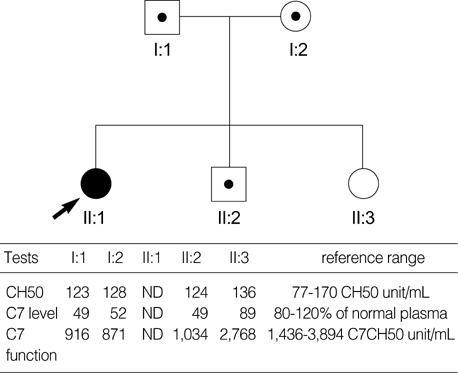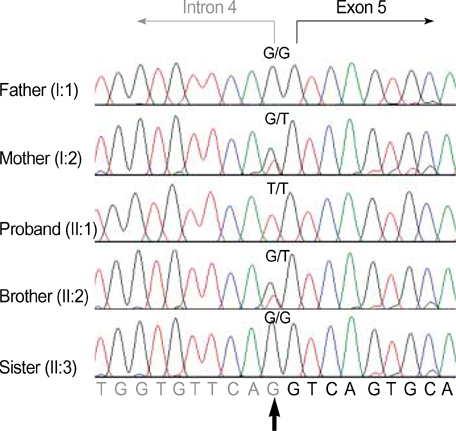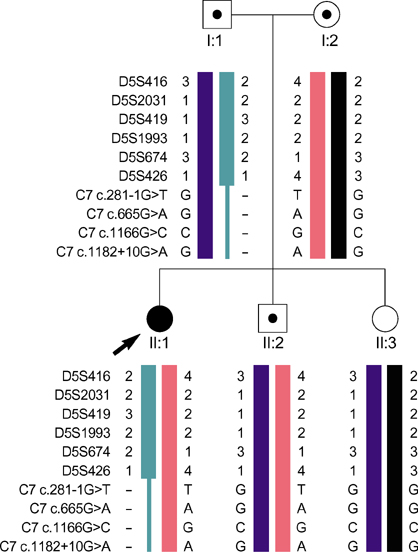J Korean Med Sci.
2005 Apr;20(2):220-224. 10.3346/jkms.2005.20.2.220.
Two Novel Mutations in the C7 gene in a Korean Patient with Complement C7 Deficiency
- Affiliations
-
- 1Department of Laboratory Medicine, Samsung Medical Center, Sungkyunkwan University School of Medicine, Seoul, Korea.
- 2Department of Pediatrics, College of Medicine, Dongguk University, Gyeongju, Korea. neogubugi@yahoo.co.kr
- 3Department of Laboratory Medicine, College of Medicine, Dongguk University, Gyeongju, Korea.
- 4Department of Laboratory Medicine, Hallym University College of Medicine, Anyang, Korea.
- KMID: 1095193
- DOI: http://doi.org/10.3346/jkms.2005.20.2.220
Abstract
- Complement C7 deficiency is an autosomal recessive disorder well known to be associated with increased susceptibility to meningococcal infection and has mostly been reported in Caucasians. In the Korean population, no case of C7 deficiency has been reported to date. Recently we experienced an 11-yr-old girl with meningococcal meningitis who was diagnosed as having C7 deficiency based upon the undetectable serum C7 protein on radial immunodiffusion and the undetectable serum total and C7 hemolytic activities. To identify the genetic basis of the C7 deficiency of the patient, we performed a mutation analysis for the C7 gene and found two novel mutations; a point mutation at the 3'splice acceptor site of intron 4 (c.281-1G>T) and a large deletion mutation encompassing almost the whole C7 gene from exon 1 to exon 17 (c.1-?_2350+?del). A haplotype analysis showed that the large deletion mutation was inherited from the patient's father. To the best of our knowledge, this is the first confirmed case of C7 deficiency in Korea.
MeSH Terms
Figure
Reference
-
1. Muller-Eberhard HJ. The membrane attack complex of complement. Annu Rev Immunol. 1986. 4:503–528.
Article2. Wurzner R, Orren A, Lachmann PJ. Inherited deficiencies of the terminal components of human complement. Immunodefic Rev. 1992. 3:123–147.3. Behrman RE, Kliegman RM, Jenson HB. Nelson textbook of pediatrics. 2000. 17th ed. Philadelphia: Elsevier Science;728–730.4. Halle D, Elstein D, Geudalia D, Sasson A, Shinar E, Schlesinger M, Zimran A. High prevalence of complement C7 deficiency among healthy blood donors of Moroccan Jewish ancestry. Am J Med Genet. 2001. 99:325–327.
Article5. Jeremiah SJ, Abbott CM, Murad Z, Povey S, Thomas HJ, Solomon E, DiScipio RG, Fey GH. The assignment of the genes coding for human complement components C6 and C7 to chromosome 5. Ann Hum Genet. 1990. 54(Pt 2):141–147.
Article6. Nishizaka H, Horiuchi T, Zhu ZB, Fukumori Y, Volanakis JE. Genetic bases of human complement C7 deficiency. J Immunol. 1996. 157:4239–4243.7. Fernie BA, Orren A, Sheehan G, Schlesinger M, Hobart MJ. Molecular bases of C7 deficiency: three different defects. J Immunol. 1997. 159:1019–1026.8. Fernie BA, Wurzner R, Orren A, Morgan BP, Potter PC, Platonov AE, Vershinina IV, Shipulin GA, Lachmann PJ, Hobart MJ. Molecular bases of combined subtotal deficiencies of C6 and C7: their effects in combination with other C6 and C7 deficiencies. J Immunol. 1996. 157:3648–3657.9. DiScipio RG, Chakravarti DN, Muller-Eberhard HJ, Fey GH. The structure of human complement component C7 and the C5b-7 complex. J Biol Chem. 1988. 263:549–560.
Article10. Hobart MJ, Fernie BA, DiScipio RG. Structure of the human C7 gene and comparison with the C6, C8A, C8B, and C9 genes. J Immunol. 1995. 154:5188–5194.11. Behar D, Schlesinger M, Halle D, Ben-Ami H, Edoute Y, Shahar E, Kasis I, Shihab S, Elstein D, Zimran A, Mandel H. C7 complement deficiency in an Israeli Arab village. Am J Med Genet. 2002. 110:25–29.
Article12. Vazquez-Bermudez MF, Barroso S, Walter K, Alvarez AJ, Alarcon A, Lopez-Trascasa M, Wichmann I, Aguilar F, Nunez-Roldan A, Sanchez B. Complement component C7 deficiency in a Spanish family. Clin Exp Immunol. 2003. 133:240–246.13. Losson R, Lacroute F. Interference of nonsense mutations with eukaryotic messenger RNA stability. Proc Natl Acad Sci USA. 1979. 76:5134–5137.
Article14. Barker GF, Beemon K. Nonsense codons within the Rous sarcoma virus gag gene decrease the stability of unspliced viral RNA. Mol Cell Biol. 1991. 11:2760–2768.
Article15. Rasmussen JM, Teisner B, Weihe P, Mathiassen B, Petersen T, Isager H. Screening for complement deficiencies in patients surviving from epidemic meningococcal disease. J Clin Lab Immunol. 1988. 25:161–165.16. Rasmussen JM, Brandslund I, Teisner B, Isager H, Svehag SE, Maarup L, Willumsen L, Ronne-Rasmussen JO, Permin H, Andersen PL. Screening for complement deficiencies in unselected patients with meningitis. Clin Exp Immunol. 1987. 68:437–445.17. Zimran A, Rudensky B, Kramer MR, Tedesco F, Ehrenfeld M, Raz R, Greif Z, Gelber M, Lishner M, Golan E. Hereditary complement deficiency in survivors of meningococcal disease: high prevalence of C7/C8 deficiency in Sephardic (Moroccan) Jews. Q J Med. 1987. 63:349–358.18. Schlesinger M, Nave Z, Levy Y, Slater PE, Fishelson Z. Prevalence of hereditary properdin, C7 and C8 deficiencies in patients with meningococcal infections. Clin Exp Immunol. 1990. 81:423–427.
Article19. Wurzner R, Witzel-Schlomp K, Tokunaga K, Fernie BA, Hobart MJ, Orren A. Reference typing report for complement components C6, C7 and C9 including mutations leading to deficiencies. Exp Clin Immunogenet. 1998. 15:268–285.
Article20. Potter PC, Frasch CE, van der Sande WJ, Cooper RC, Patel Y, Orren A. Prophylaxis against Neisseria meningitidis infections and antibody responses in patients with deficiency of the sixth component of complement. J Infect Dis. 1990. 161:932–937.
Article21. Salmon JE, Edberg JC, Brogle NL, Kimberly RP. Allelic polymorphisms of human Fc gamma receptor IIA and Fc gamma receptor IIIB. Independent mechanisms for differences in human phagocyte function. J Clin Invest. 1992. 89:1274–1281.
Article22. Fijen CA, Bredius RG, Kuijper EJ, Out TA, De Haas M, De Wit AP, Daha MR, De Winkel JG. The role of Fcgamma receptor polymorphisms and C3 in the immune defence against Neisseria meningitidis in complement-deficient individuals. Clin Exp Immunol. 2000. 120:338–345.23. van der Pol WL, Huizinga TW, Vidarsson G, van der Linden MW, Jansen MD, Keijsers V, de Straat FG, Westerdaal NA, de Winkel JG, Westendorp RG. Relevance of Fcgamma receptor and interleukin-10 polymorphisms for meningococcal disease. J Infect Dis. 2001. 184:1548–1555.24. Tsokos GC, Liossis SN. Immune cell signaling defects in lupus: activation, anergy and death. Immunol Today. 1999. 20:119–124.
Article25. Hoare S, El-Shazali O, Clark JE, Fay A, Cant AJ. Investigation for complement deficiency following meningococcal disease. Arch Dis Child. 2002. 86:215–217.
Article26. Drogari-Apiranthitou M, Fijen CA, Van De Beek D, Hensen EF, Dankert J, Kuijper EJ. Development of antibodies against tetravalent meningococcal polysaccharides in revaccinated complement-deficient patients. Clin Exp Immunol. 2000. 119:311–316.
Article
- Full Text Links
- Actions
-
Cited
- CITED
-
- Close
- Share
- Similar articles
-
- A Case of Hereditary C7 Deficiency Associated with Meningococcal Meningitis
- A Case of Meningococcal Sepsis and Meningitis with Complement 7 Deficiency in a Military Trainee
- A Korean familial case of hereditary complement 7 deficiency
- A Case of Deficiency of the Seventh Component of Complement with Recurrence of Meningococcal Meningitis and Septicemia
- Frequency and Quantity of the C7 Contribution to the Ulnar Nerve





